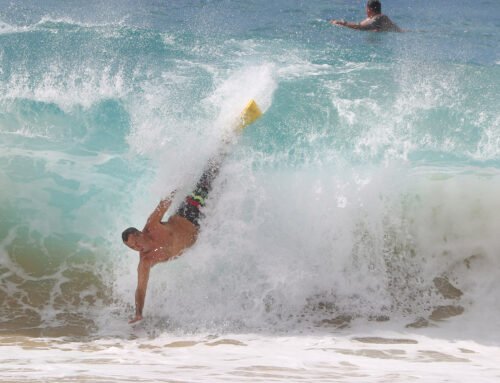One person’s recent actions have sounded alarms on both sides of issues regarding tourism and wildlife. To those advocating for mindful, responsible tourists, this event is an example of why that language needs to be in place. And to animal rights advocates, it’s an example of work needed to stop such situations from happening again. But there’s something else here, too.
When we saw the widely distributed video of a visitor trying to ride a stranded whale calf along Waikiki, we couldn’t help but be reminded of two Hawaii hotel programs that allow guests to be near and interact with captive dolphins. The promotional video below shows how a dolphin encounter at the Kahala Resort on Oahu could lead some to believe that Hawaii wildlife, perhaps even in our oceans, can be encountered without fear. Watch the 90-second video below and see if you concur. Here, you have visitors swimming with dolphins, which may give the wrong impression that it is okay.
Please keep an appropriate distance from Hawaii wildlife.
NOAA and DLNR recommend, for your safety and the protection of animals, all persons stay at least:
- 10 feet from sea turtles (both on land in the water)
- 50 feet from Hawaiian monk seals, or remain behind any signs or barriers
- 50 yards from dolphins and small whales (and do not swim with them)
Now contrast the Dolphin Quest video with one this week showing a visitor trying to jump on the back of a 12-foot-long whale calf in front of the Hale Koa Hotel at Waikiki. The baby whale was seen without its mother. The event happened Wednesday afternoon, and the baby whale has not been spotted since. This led the troubled Hawaii Tourism Authority’s new chair to jump into the fray with his comment below.
One of the key messages in HTA’s visitor education program is that wildlife should be admired from afar. This incident reminds us all that the right thing to do when coming across wildlife is to respect their space, and if they are in trouble, notify the authorities.
Mufi Hannemann, Chair of HTA
HTA also asks that visitors who see Hawaii wildlife in trouble, “Use your camera or cell phone to take a photo of the animal from a safe distance. This can help responders identify the species and the steps necessary to help it. Wait (if you can) for a trained and authorized responder to arrive so you can help them locate the animal. Watch it from a safe distance. Don’t chase or corral the injured animal if it tries to move away. Keep the area calm and quiet (to the extent you can), and encourage others to keep their distance and keep dogs on a leash.
Two Hawaii hotels feature controversial dolphin experience programs.
Contentious dolphin experience programs exist at two Hawaii hotels, and Dolphin Quest runs both. They unquestionably give the impression that at least some wildlife can be approached and will enjoy interacting with us. The hotels are Kahala on Oahu and Hilton Waikoloa Village on Big Island and they charge about $300 per person for the experience. We stayed at Kahala again a year ago and loved the property and location, but the dolphin program keeps us away so long as that program exists. Dolphins swim as much as 40 to 60 miles daily in their natural environment as they travel with family and friends.
Despite the ubiquitous images of happy-looking dolphins and laughing children you’ve probably seen before, don’t be fooled by their smiles. Dolphins living in captivity are suffering silently for the sake of entertainment
World Animal Protection Program
Have you ever seen wildlife disturbed in Hawaii?






Leave A Comment